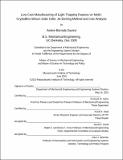| dc.contributor.advisor | Emanuel M. Sachs. | en_US |
| dc.contributor.author | Berrada Sounni, Amine | en_US |
| dc.contributor.other | Massachusetts Institute of Technology. Technology and Policy Program. | en_US |
| dc.date.accessioned | 2011-03-07T14:39:09Z | |
| dc.date.available | 2011-03-07T14:39:09Z | |
| dc.date.copyright | 2010 | en_US |
| dc.date.issued | 2010 | en_US |
| dc.identifier.uri | http://hdl.handle.net/1721.1/61522 | |
| dc.description | Thesis (S.M.)--Massachusetts Institute of Technology, Dept. of Mechanical Engineering; and, (S.M. in Technology and Policy)--Massachusetts Institute of Technology, Engineering Systems Division, Technology and Policy Program, 2010. | en_US |
| dc.description | This electronic version was submitted by the student author. The certified thesis is available in the Institute Archives and Special Collections. | en_US |
| dc.description | Cataloged from student-submitted PDF version of thesis. | en_US |
| dc.description | Includes bibliographical references (p. 127-128). | en_US |
| dc.description.abstract | An experimental study was conducted in order to determine low cost methods to improve the light trapping ability of multi-crystalline solar cells. We focused our work on improving current wet etching methods to achieve the desired light trapping features which consists in micro-scale trenches with parabolic cross-sectional profiles with a target aspect ratio of 1.0. The jet etching with a hard mask method, which consists in impinging a liquid mixture of hydrofluoric, nitric and acetic acids through the opening of hard mask, was developed. First, a computational fluid dynamics simulation was conducted to determine the desired jet velocity and angle to be used in our experiments. We find that using a jet velocity of 3 m/s and a jetting angle of 45° yields the necessary flow characteristics for etching high aspect ratio features. Second, we performed experiments to determine the effect of jet etching using a photo-resist mask and thermally grown silicon oxide mask on multiple silicon substrates : <100>, <110>, <111> and multi-crystalline silicon. Compared to a baseline of etching with no jet, we find that the jet etching process can improve the light trapping ability of the baseline features by improving their aspect ratio up to 65.2% and their light trapping ability up to 38.1%. The highest aspect ratio achieved using the jet etching process was 0.62. However, it must be noted that the repeatability of the results was not consistent: significant variations in the results of the same experiment occurred, making the jet etching process promising but difficult to control. Finally, we performed a cost analysis in order to determine the minimum efficiency that a jet etching process would have to achieve to be cost competitive and its corresponding features aspect ratio. We find that a minimum cell efficiency of 16.63% and feature aspect ratios of 0.57 are necessary for cost competitiveness with current solar cell manufacturing technology. | en_US |
| dc.description.statementofresponsibility | by Amine Berrada Sounni. | en_US |
| dc.format.extent | 132 p. | en_US |
| dc.language.iso | eng | en_US |
| dc.publisher | Massachusetts Institute of Technology | en_US |
| dc.rights | M.I.T. theses are protected by
copyright. They may be viewed from this source for any purpose, but
reproduction or distribution in any format is prohibited without written
permission. See provided URL for inquiries about permission. | en_US |
| dc.rights.uri | http://dspace.mit.edu/handle/1721.1/7582 | en_US |
| dc.subject | Mechanical Engineering. | en_US |
| dc.subject | Engineering Systems Division. | en_US |
| dc.subject | Technology and Policy Program. | en_US |
| dc.title | Low cost manufacturing of light trapping features on multi-crystalline silicon solar cells : jet etching method and cost analysis | en_US |
| dc.type | Thesis | en_US |
| dc.description.degree | S.M.in Technology and Policy | en_US |
| dc.description.degree | S.M. | en_US |
| dc.contributor.department | Massachusetts Institute of Technology. Department of Mechanical Engineering | |
| dc.contributor.department | Massachusetts Institute of Technology. Engineering Systems Division | |
| dc.contributor.department | Technology and Policy Program | |
| dc.identifier.oclc | 703599406 | en_US |
